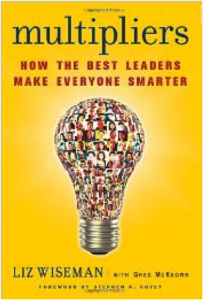 Liz Wiseman and Greg McKeown. Multipliers: How the Best Leaders Make Everyone Smarter. New York: HarperCollins, 2012.
Liz Wiseman and Greg McKeown. Multipliers: How the Best Leaders Make Everyone Smarter. New York: HarperCollins, 2012.
Renee Snow
The opening quote of Multipliers summarizes the grand tour theory that those who are Multipliers make those they encounter feel like the smartest people in the room, while Diminishers suck the brainpower out of others by making sure people know that they hold the exclusive rights to intelligence. Written by Wiseman, an ex-Oracle executive, and McKeown, a student in Stanford’s Graduate School of Business, Multipliers contains a set of five practices leaders can adopt to tap into the resource of dormant potential in their ranks. The disciplines indicate how leaders manage talent, approach mistakes, set direction, make decisions, and accomplish tasks. These five disciplines were derived from qualitative interviews of more than 150 leaders along with quantitative assessments of their practices. The authors dichotomize leaders into two schools, Multipliers and Diminishers and examine how each performs under the five practices. Each chapter begins with a case study of a Multiplier’s approach to one of the five disciplines. Through these case studies the sub-practices associated with each discipline are illustrated. Next, the authors demonstrate, again through a case study, the actions of a Diminisher under the same scenario. The final page of each chapter summarizes the key findings and practices associated with each discipline.
Similar to Stephen Covey’s The 7 Habits of Highly Effective People, Wiseman and McKeown assume Multipliers can be cultivated through adherence to the practices summarized at the end of each chapter. The book’s heavy emphasis on Western corporate leadership fails to address the individualistic philosophical underpinnings corporate leaders are steeped in before arriving in leadership positions. Behavioral modification can be an effective tool for changing superficial qualities, but deeper issues may remain untouched through this method. To their credit, the authors note this and gear the discussion to leaders on the verge of becoming Multipliers. The concise, clearly-written chapters have the tone of a business memo where the authors understand they have only a moment to capture the attention of the reader. Pragmatism rather than scholarship reigns throughout the work. Still, the major themes of the book are well-developed and understandable. Sadly, the very people who should adopt the practices, the Diminishers, are likely to dismiss the work since to incorporate the practices would be to remove themselves from the spotlight and allow others to shine.
In integral terms Multipiers addresses only the It/Its quadrants of leadership neglecting the subjective personal and collective. As a result of this omission many integral readers may find the work one-dimensional. The target audience, corporate managers hoping to invigorate their workforces, will learn strategies to transform themselves into Multipliers. However, this transformation presupposes a high level of consciousness and ability to transcend ego. In summary, Multipliers is a useful book for leaders looking for behaviors that will inspire those under their management to work to their potential.
— Renee Snow

